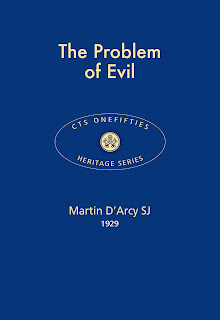Nuns - What are they for?
CTS Onefifties Book 11
Maria Boulding
Bruno Webb
Jean Daniélou
ISBN 9781784695361
eISBN 9781784695088
ASIN B075FWGRNW
CTS Booklet CL10
I picked up this volume after reading two others from the Catholic Truth Society that seemed related, they were:
Over the last several years I have read over 275 books and booklets from the CTS. And So far this year have alternated CTS titles with other volumes. But this book is very different from the other two. In 2016 during the 150 Anniversary of the CTS they released special editions of 150 of their most popular and influential booklets. We are told about the series that:
“CTS Publisher Fergal Martin said, “1868 to 2018 we feel is something to celebrate. We have delved into our archives of thousands of titles and uncovered countless gems that celebrate the huge range and diversity of CTS publishing across a century and a half. The CTS archive represents a unique and valuable resource chronicling the changing concerns of the Catholic population of the British Isles and beyond over the last 150 years. There is something original and special here for everybody. Our hope is that readers can dip into the past – and find the present.””
This volume was actually compiled from three other works. They are:
Contemplative Nuns: Are They Wasting Their Lives? – Maria Boulding OSB 1973
Why Enclosed Nuns – Dom Bruno Webb OSB 1951
Nuns – What Is Special About Them? – Jean Cardinal Danielou SJ 1974
The description of this new combined edition is:
“There are two sorts of nuns: those you see and those you don’t. Some are visibly busy doing good; but what about those you don’t see? Three classic CTS texts are combined in this explanatory title.
In Contemplative Nuns: are they wasting their lives?, Maria Boulding, a highly-respected spiritual writer and translator, gave her testimony as contemplative nun, in a way both eloquent and forceful. The second text Why Enclosed Nuns? written by Bruno Webb a generation earlier is more theoretical, though written with a robust sense of the reality of enclosed life. The third text written by Jean Daniélou as Nuns – what is special about them? came in the immediate aftermath of the Conciliar reforms when religious life was beginning to change. In this text, he insists the religious vocation depends on unfashionable elements such as formal prayer, living under obedience, wearing a habit. These, he argues, are both prophetic signs and an essential framework to allow God’s grace to work unhindered by our egotism. The vocation is expressed primarily in the experience of loving God and being loved by him. It is to this that contemplative nuns above all are called.”
The final section of the book is background to the authors and these specific works:
“Maria Boulding was a highly-respected spiritual writer and translator, notably of St Augustine. Her testimony, as a contemplative nun, is eloquent and forceful: “love is the mightiest source of power in the world, and because of the solidarity of mankind contemplatives believe that lives handed over to love can make a difference”.
Bruno Webb’s text, from a generation earlier, is more theoretical, although with a robust sense of the reality of enclosed life.
Jean Daniélou wrote in the immediate aftermath of the Conciliar reforms, and the wholesale recasting of much religious life. He insists the religious vocation depends on unfashionable elements such as formal prayer, living under obedience, wearing a habit: these are both prophetic signs and an essential framework to allow God’s grace to work unhindered by our egotism. The vocation is expressed primarily in the experience of loving God and being loved by him. It is to this that contemplative nuns above all are called.”
Some online descriptions are this final section. This book was a fascinating read. I read it through in a single sitting over a large mug of tea. I was surprised the three components were not put in chronological order. But each of the three are informative. I follow several nuns on social media, and even a young woman who is about to enter a Carmelite cloister. I know that in recent years there has been a rise in this type of vocation. This volume would be great for those discerning I was very intrigued at the end of the first section about the list of: Enclosed Communities Of Nuns In England, Scotland And Wales. And also the list at the end of the second: Enclosed Communities Of Nuns In England & Wales. I would have loved if there was an appendix with current lists for each of these categories, but other than that an excellent volume.
I have only read a few of the CTS Onefifties but have benefited from each of them, and look forward to reading many more. This is an excellent read and one I benefited from.
Note: This book is part of a series of reviews: 2022 Catholic Reading Plan! For other reviews of books from the Catholic Truth Society click here.
Related posts:
…




No comments:
Post a Comment